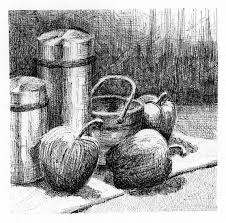9 Visual Art 1
Section outline
-
 Steampunk Fish Sculptures
Steampunk Fish Sculptures

 .
. Your challenge….
I want you to take risks, think ‘outside the square’ and have a go at creating a sculpture of a fish with a robotic /steampunk feel. There will be some criteria to follow but you need to do lots of drawing and planning and practising with materials before you create your final sculpture
-
Learning Intentions"
- We are learning to draw from observation focusing on accuracy and correct proportion.(Practical Knowledge)
- We are learning to annotate around our drawings to give extra information for planning purposes (Developing Ideas)
Success criteria
- Your workbook will have detailed drawings of three fish shapes. They will be shaded to look three-dimensional and show as much detail in the fins and body structure as possible.
DUE END OF WEEK 2
Example
 .
.  .
. -
How do we get from this to this?
 ...............
...............
We are learning to
- Investigate the art style of steampunk to inform help our creativity . (Communicating and Interpreting)
- Use our knowledge of steampunk art to create ideas for a fish sculpture (Developing Ideas)
Success Criteria
- Using the provided resource on Steampunk art, create a workbook page which outlines the main points about the art. You should have a mixture of facts and images on your page. The images don't have to be fish but examples of the steampunk style.
- You will show drawings which begin to morph realistic outlines of fish shapes into a robotic/steampunk style of drawing.
-
We are learning to:
Create the framework and decorative techniques for our robotic fish
To Do:
You should be now beginning to think about the final decorative techniques you need on your fish. Most of the outer layer should be complete and you should be solving the problem of how to make it look futuristic and robotic in your drawings and final plan.
You should have a final plan that is a detailed drawing of your fish and how it will hopefully look. List the materials you will use.
-
We are learning to:
Create a sturdy structure for our fish using a selection of building materials.
To Do:
Whether you have selected, wire, cane, used a plastic bottle and adding on to it, your sculpture for the first layer should be secure and sturdy. There should be tidy joins and neat workmanship to build the first layer.
-
We are learning to:
Create a sturdy structure for our fish using a selection of building materials.
To Do:
Whether you have selected, wire, cane, used a plastic bottle and adding on to it, your sculpture for the first layer should be secure and sturdy. There should be tidy joins and neat workmanship to build the first layer.
-
We are learning to:
Create the framework for our fish and begin covering the outer layer with paper mache or the planned finishing of our design.
To Do:
Complete all of the framework and begin the outer layer of your fish. Check that your structure is sturdy before starting this stage of the process.
-
We are learning to
Practise our observational drawing and demonstrate a variety of shading techniques
To do:
Watch this you tube video to help you practise your shading techniques. At the end of the video there are some suggested examples for you to work on. Have a go at completing the tasks and show the evidence in your visual diary.
-
Mural Challenge
Mr Morrison wants to see a mural designed and painted on the right hand brick wall under the canopy at the end of the school before you walk up the steps to Valderama Drive. He has provided me with a model of a mural that demonstrates visions and goals and asked if I could design it for him. I need help.
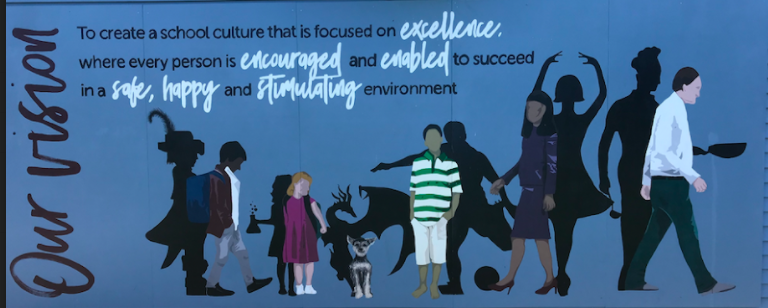
Your mission:
Using our school goals and key words listed below and looking at Mr Morrison's example as a starting point see what mural idea you can come up with. The key words and vision statement are as follows
- Growing Greatness or Kia mana ake
- Mission Heights Junior College is committed to provide innovative and evolving personalised learning to enable students to be confident, active, reflective and high-achieving independent learners.
-
 .
. 

Your pop art challenge
You are to create a composition that reflects the pop art style
It will be a painting
Your composition will have the following criteria:
- It should like a comic strip section
- There should be a silhouette of a student/s in your work (make sure it is the silhouette of a Middle School student age)
- Objects could overlap
- Objects could disappear off the side of the page
- The colours are restricted to yellow, blue, red with black and white.
- There should be an element of the schools values somewhere on your work (this could be in the form of text or the image may show it.
NB: This week we are in the planning stage so you should have several drawings in your visual diary. Don't just be satisfied with the first attempt as there are many possibilities to experiment with on how your work could look. What does it look like in a square? A thought bubble? A rectangle?
-
 .
. 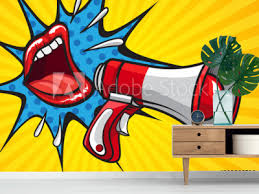 .
. 
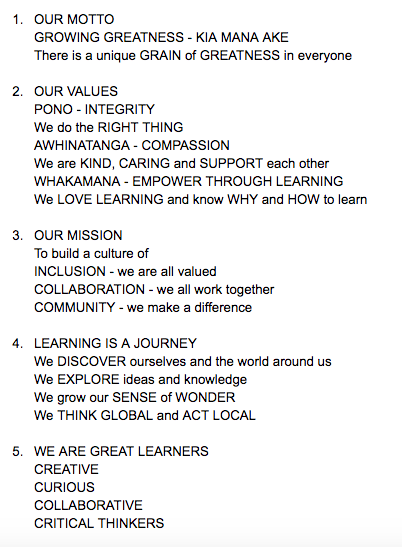
-
Alice and Wonderland
“Alice in Wonderland” is a surreal artist’s dream. There are so many features of the story that contain surrealist elements and the characters are quirky and imaginative.
On a page in your visual art diary do the following tasks to introduce our next topic.
Surrealism
Make a title "Surrealism"
Draw a text box and explain the definition of surrealism.
List the main features of surrealism.
Explain what POP SURREALISM is.
Now look at the story line of “Alice in Wonderland” (Create a title on a new page)
List the main characters that are in the story.
Look at the scenes in the storyline
Find images of your favourite character but look at pop surrealist images to find examples

-
We are learning to understand what surrealism and pop surrealism are.
To Do: Complete an artist research page in your visual art diaries with the following information. make your pages as creative and informative as you can by following the criteria.
Make a title "Surrealism"
Draw a text box and explain the definition of surrealism.
List the main features of surrealism.
Add some printed images of surrealist art to your pages and make a not of the artist beside each. (look for Henry Magritte and Salvador Dali examples that are appropriate)
On a new page Explain what POP SURREALISM is and follow the same criteria as above for Surrealism.
 .
. 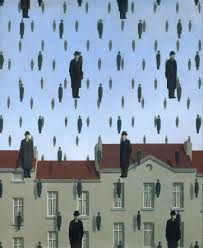
-
We are learning to look at characters and settings in a movie and practice drawing them.
Alice in Wonderland is a fabulous story with a surrealist feel. Use the google slide show link to access the movie and watch it, making drawings of the characters as you go. You will find the link to watch the movie on slide 7 (pictured below)
https://docs.google.com/presentation/d/1cG4uFYfshAzm4wtBYprU3njzcapQTseYxmTgAiyBVYg/edit#slide=id.g531a92199c_0_10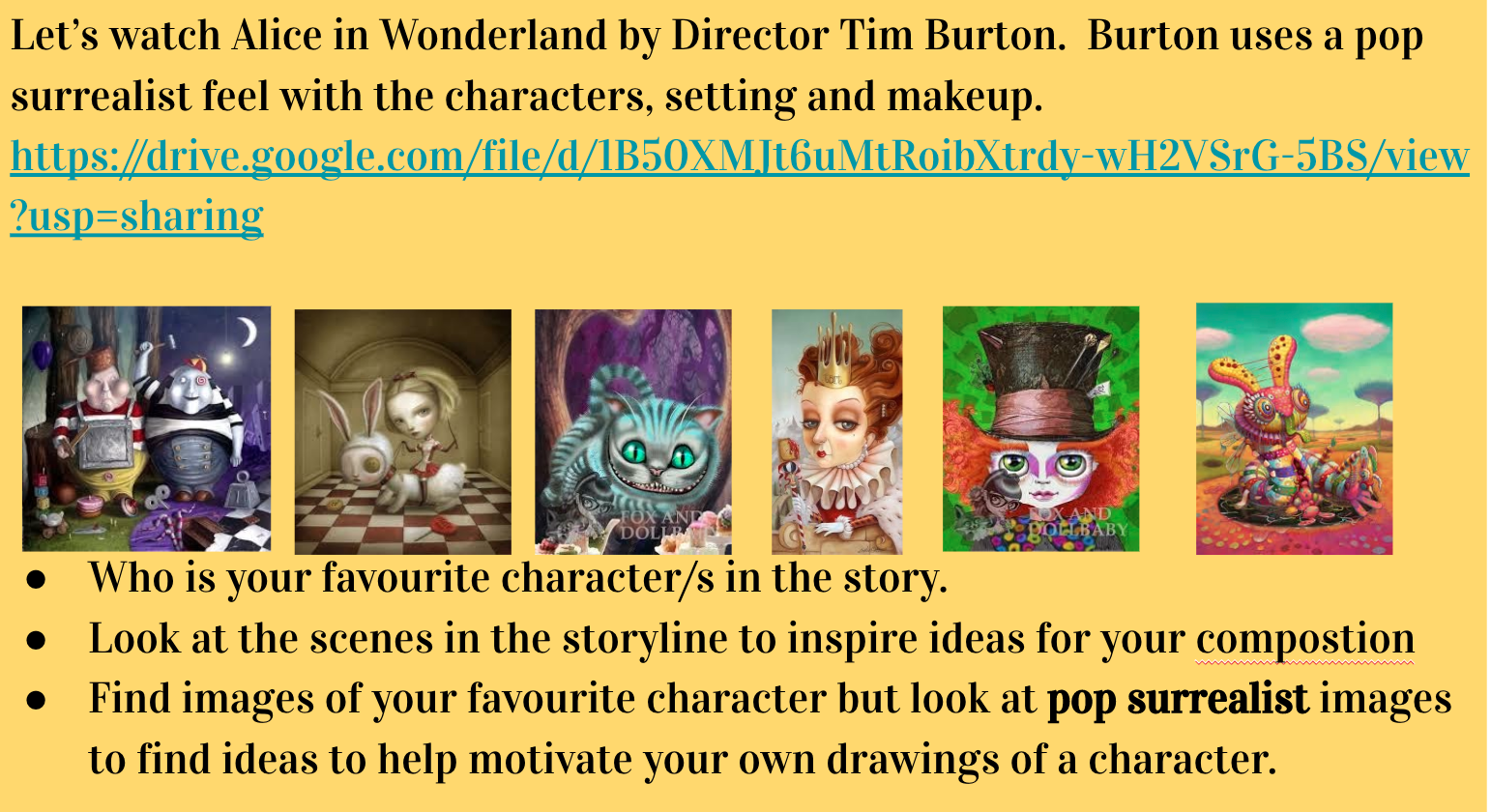
-
We are learning to investigate a pop surrealist artist for ideas on how we develop our character drawings.
On slide 6 of the slide show presentation, you will see examples of a pop surrealist artist. look at the examples of her work and see if you can create some detailed pencil or pen sketches to your characters from Alice that show her style has been included.
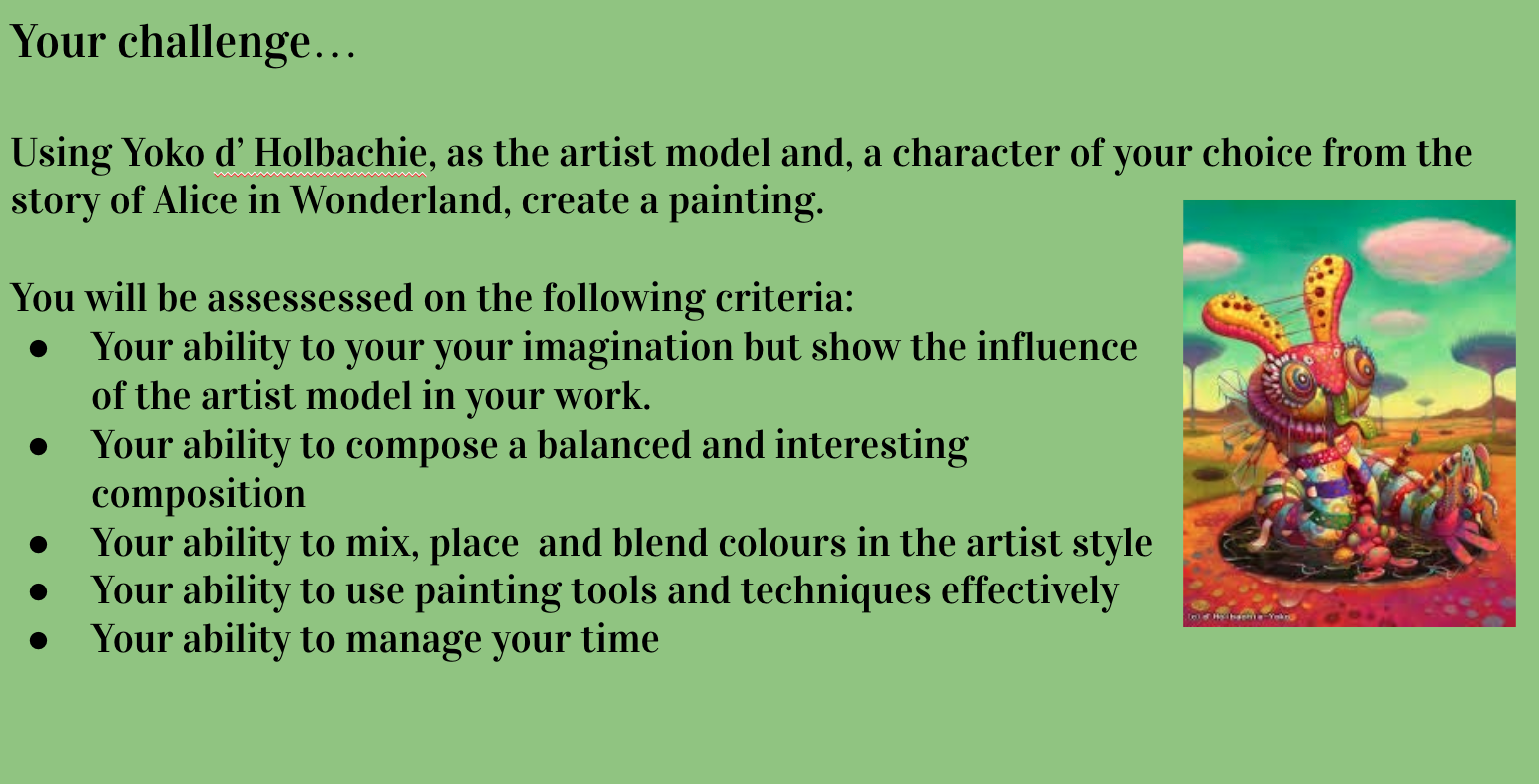
-
Link to Google slide show for surrealism meets pop surrealism art unit
Keep working to develop and draw your pop surrealist art images of character from Alice in Wonderland.
https://docs.google.com/presentation/d/1cG4uFYfshAzm4wtBYprU3njzcapQTseYxmTgAiyBVYg/edit#slide=id.g8f7d7f142a_1_7
Extra for wet days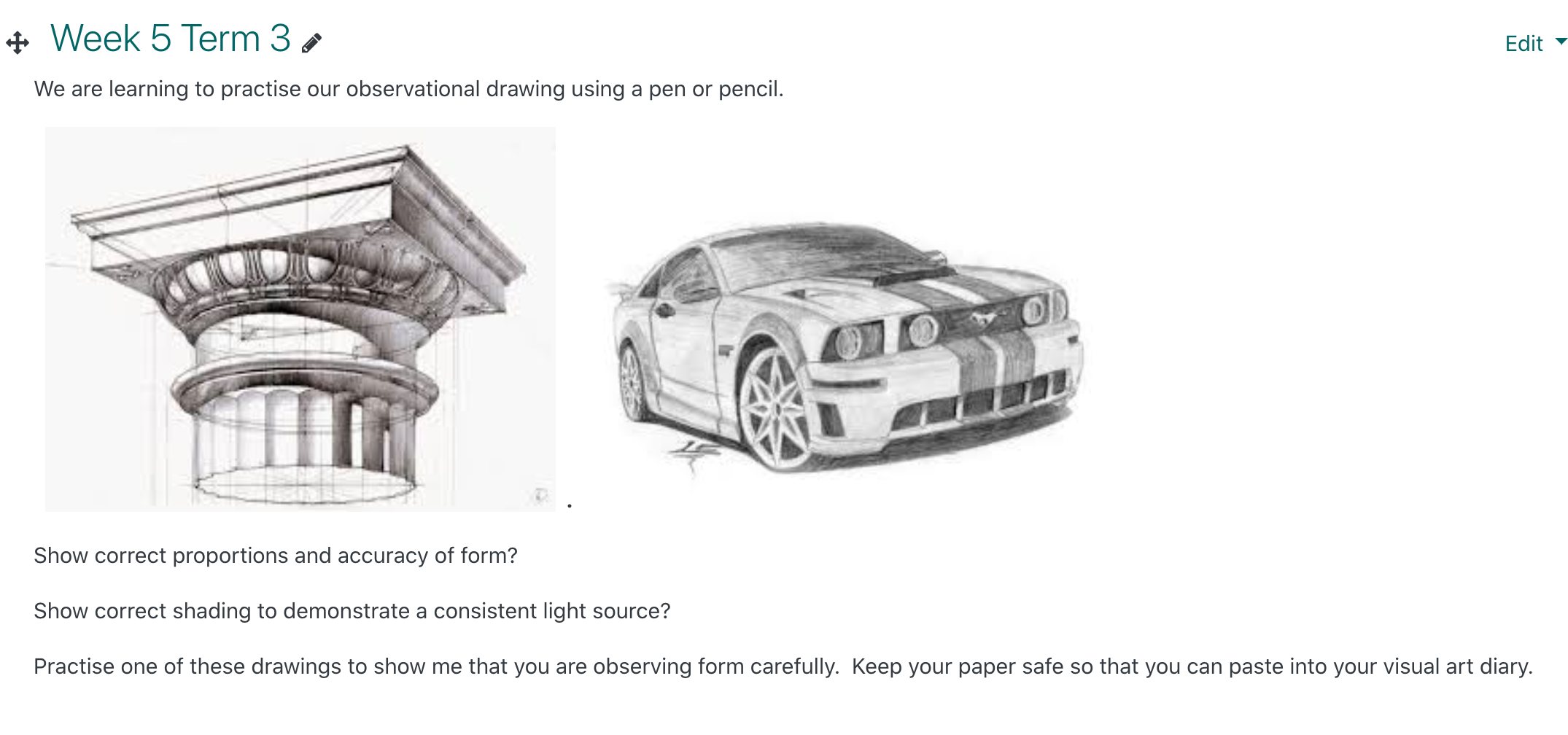
-
We are learning to focus on drawing accurately and in proportion with well executed tonal shading.
Check out this short video showing off the work of an artist called Redmer Hoekstra. He loves morphing objects into other objects or creating whimsical surrealist images.
If you have finished the plan for your Alice in Wonderland composition, then you can practise your drawing skills by completing a copy of one of his drawings. Be sure to focus on accuracy and proportion and most importantly, the tonal shading to create that sense of form.
-
.
 .
. 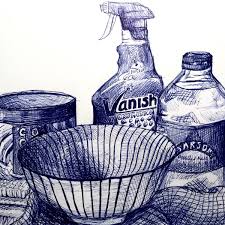 .
.  .
. 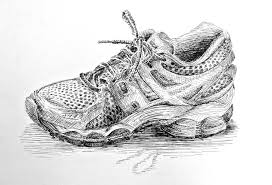
-
We are learning to use different pen techniques to show form in our drawings
Watch these video to help give you some extra tips on how to show form using a pen.
-

Let's get started... Some skills and knowledge experiments
Learning Intention: This week you will have a week of practising to nmix colours and practise different techniques such as blending and dry brush.
To Do:
1. In your Visual art diaries head up a page titled "Paint mixing and Colour Theory"
2. Find a colour wheel online and print it out for your book. List the primary colours, Secondary colours and describe how to create tints and shades.
3. Look at the example of the painting above and in particular, the background. Using the 'Global' colour range of paints that we have, practise mixing and showing the colours of the pink clouds, sky background and ground colours in your book.
-
Planning your painting
Learning Intention: Preparing the background of your paper and building up images
Last term you were asked to practise drawing and refining a character from the story of "Alice in Wonderland". It's time to begin painting that composition. I'm going to use the cheshire cat and give him a 'Hawain' feel like this print below.
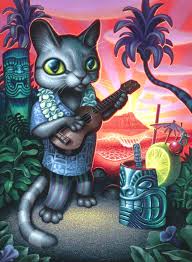 .
. 
To Do:
1.Think about the colour scheme in the background of your painting. What sort of mood are you trying to convey?
2Divide your background into two or three areas. i'e..a sky and ground or structure, ground and sky or just internal walls of a room. Mix up light tones of the paint colours you require for each section and paint a base layer.
3Work over those layers with dry brush or blending until you get the desired finish.
4Draw your characters over the top of the background
NB: If you paint a very dark background colour your character will have to be pencilled in first as it is often harder with acrylic paint to paint over darker colours.
-
Building up images and interest
We are learning to layer up over our painting and create more images and interest to the composition.
To Do:
Questions to ask yourself....What other objects do you want in your work? Plants, building structures, other characters, objects of interest?
Draw these and and begin painting them.
Keep thinking about balancing the colour around your composition. In this example the grey base colour for the objects is a nice contrast to the pink background but it is balanced throughout the composition. The colour scheme is also pretty limited with the colours. This helps it to look balanced.


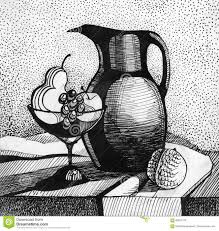 .
. 

